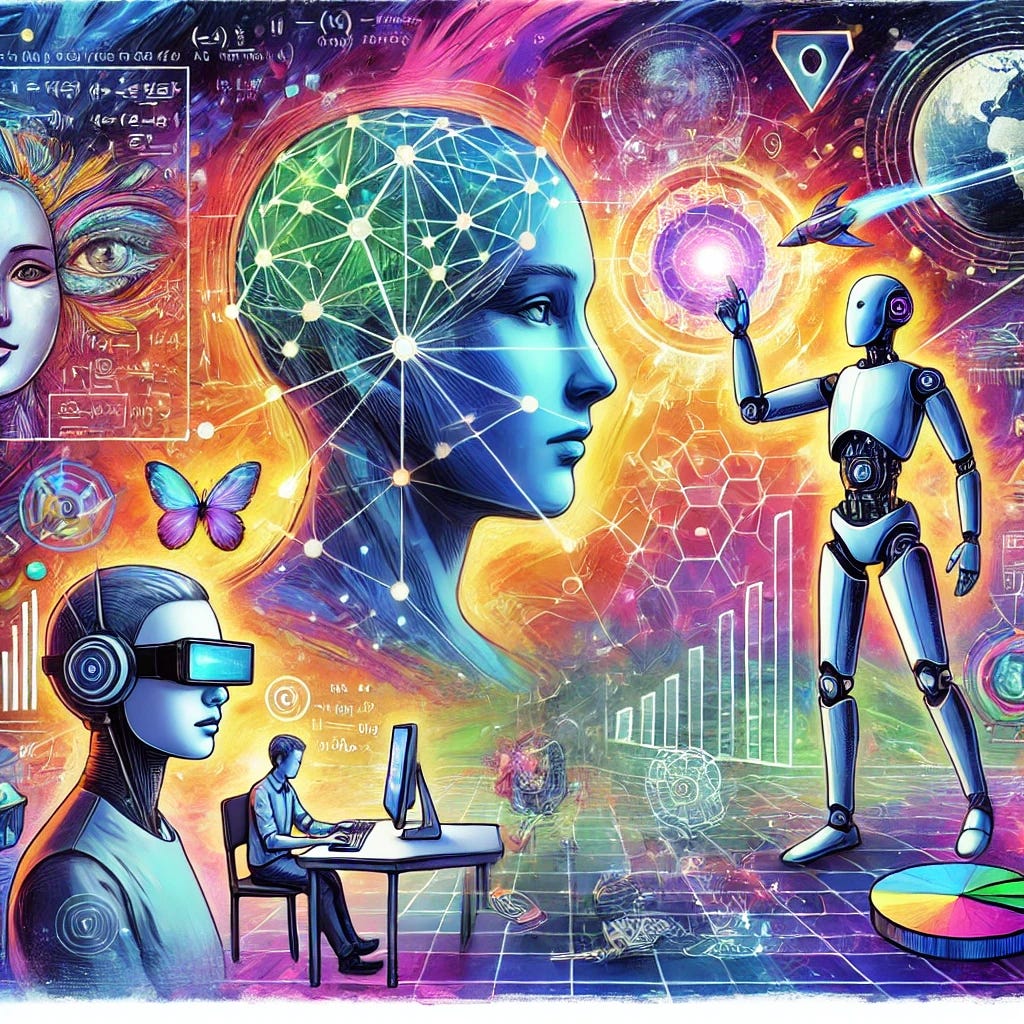Today, I’m not here to unveil rockets, tweet memes, or showcase electric vehicles, but to talk about the digital frontier. A world where AI, AR, and the convergence of tech are not just tools but companions, guides, and innovators reshaping our lives. Let me sum up some fascinating developments in a style that's, well, uniquely "not everyday Andy."
First, OpenAI. They’re turning chatbots into visual and interactive tutors. Imagine holding up your phone, pointing at a broken gadget, and asking, “Fix this!” Now it can. ChatGPT with real-time video streaming and screen-sharing takes us from static conversations to dynamic problem-solving. It’s like having a Swiss Army knife of advice in your pocket. This evolution isn’t just about convenience; it’s about how we interact with the tech around us.
Anthropic enters stage left with Clio—a watchdog for digital conversations. Their model doesn’t just predict or chat; it safeguards. By analyzing vast conversation patterns, it’s tackling misuse while improving AI’s understanding of what’s benign. Think of it as both the knight and the architect of safer, smarter AI ecosystems.
And Microsoft? They’re doing something small—but mighty. Phi-4, a language model with a fraction of the size but double the brains, tackles math and reasoning like a pro. Efficiency meets intelligence, a balance that might just redefine the AI race.
Next, let’s talk about Elliot Horowitz, co-founder of MongoDB, who is now reinventing what it means to "make things smarter." His startup, Viam, is blending AI with everyday hardware to transform functionality. From reducing bathroom wait times at UBS Arena using computer vision to helping Sbarro keep their pizza fresh, it’s the kind of ingenuity that marries practicality with innovation. Horowitz is proving that even the mundane can benefit from a touch of intelligence.
Meta, of course, brings their Metaverse tools to life. Motion tracking for avatars, neural video watermarking for content security—it’s a blend of creativity and accountability. If you're thinking, "Hey, this sounds like sci-fi," well, yes. But the kind of sci-fi we’re making real.
Meanwhile, Apple’s “Proxima” chip aims to rewrite wireless connectivity in a way that screams, "We make our own rules." Integrating Bluetooth, Wi-Fi, and their 5G modem, it’s a bold step toward hardware sovereignty….And let’s not forget Google. They’re crafting smart glasses with AI assistants. Imagine your glasses telling you the name of that plant or instantly translating a street sign in Tokyo. It’s not magic—it’s just where we’re heading.
From smarter bots to interconnected realities, we’re not just watching technology evolve; we’re part of the transformation. The future’s a game of synergy, and the rules? We’re writing them in real-time, just as we’re writing THE COMUNICANO!!!
Andy Abramson
OpenAI Watch
Look and See What’s Talking—OpenAI has enhanced ChatGPT's Advanced Voice Mode by introducing real-time video streaming and screen-sharing capabilities. This update allows users to engage in dynamic, multimodal interactions, such as receiving step-by-step guidance on tasks like assembling furniture or troubleshooting devices. By simply pointing their smartphone cameras at objects or sharing their device screens, users can obtain immediate, context-aware assistance. These features are currently rolling out to ChatGPT Plus, Pro, and Teams users on iOS and Android platforms, with plans to extend access to Enterprise and Education users in January.
AI Watch
Watching What They Do—Anthropic's AI-powered Clio tool uses machine learning to uncover hidden patterns and threats in chatbot interactions, offering a bottom-up approach to identify coordinated misuse, such as SEO spam networks. It analyzes over a million conversations, clustering them to detect unusual behavior, while safeguarding privacy. This method also refines Claude’s responses to benign queries often misclassified as harmful. Clio's insights extend to top user activities like coding, education, and business strategy. By sharing Clio’s methodology and costs, Anthropic hopes to inspire similar trust and safety innovations across AI labs, enhancing real-world applications and addressing evolving AI challenges.
Pin Me Down—Microsoft introduces Phi-4, its latest 14-billion parameter small language model excelling in complex reasoning, particularly in mathematical problem-solving. Phi-4 outperforms larger models by leveraging high-quality synthetic and organic datasets, alongside innovative post-training techniques. Available via Azure AI Foundry and soon on Hugging Face, Phi-4 represents Microsoft's commitment to balancing model size with performance. Designed with robust responsible AI capabilities, developers can integrate content safety features and monitor for quality, adversarial prompts, and data integrity. Phi-4 underscores Microsoft's drive to empower organizations with advanced AI tools while ensuring ethical and secure applications.
Meta Watch
Tatoo You—Meta's Fundamental AI Research (FAIR) team has introduced new tools advancing Metaverse and AI watermarking. Among them, Motivo is a model trained to perform diverse full-body tasks, like motion tracking and pose reaching, achieving human-like behavior without task-specific training. This innovation aims to support lifelike, fully-embodied agents for the Metaverse. Then there’s"Video Seal," which provides neural video watermarking to track content origins, even after editing. Meta also launched tools like Flow Matching for multimodal outputs (e.g., video, audio, 3D), and frameworks for evaluating AI diversity. These advancements emphasize Meta's focus on enhancing AI reliability and virtual character realism.
Putting A Seal on That—Meta has unveiled Video Seal, an open, efficient framework for neural video watermarking to address the challenges posed by AI-generated content and video editing. The framework integrates an embedder and extractor, ensuring robust watermarking that remains effective despite distortions like compression and geometric transformations. By introducing temporal watermark propagation, it avoids the need to watermark every frame, enhancing efficiency. The model achieves high robustness against baselines, with notable speed and imperceptibility. Video Seal emphasizes transparency and accessibility, offering open-source code and tools to foster further research, underscoring Meta's commitment to content authenticity and security in the digital age.
Keeping Up With The Joneses—Threads is reportedly testing a new feature inspired by Bluesky's "starter packs," designed to simplify the onboarding process for new users. These curated packs recommend specific accounts for users to follow based on their interests, providing a more personalized and engaging experience on the platform. This move aims to enhance user engagement and retention, aligning Threads more closely with competitors like Bluesky. The initiative reflects Meta's broader strategy to innovate within the social media landscape by adopting and adapting successful features from rival platforms.
Robot Watch
Making Things Smarter—Eliot Horowitz, co-founder and former CTO of MongoDB, has launched Viam, an AI startup aiming to infuse intelligence into everyday objects. Situated on New York's Sesame Street, Viam's platform integrates software with existing hardware to enhance functionality across various industries. For instance, Viam collaborates with UBS Arena to reduce bathroom wait times using computer vision, providing real-time data to fans via the arena's app. Additionally, Sbarro utilizes Viam's technology to monitor pizza freshness and sales trends, while sportfishing company Canyon Runner analyzes boat data to improve fishing outcomes. Despite raising $87 million in funding, Viam faces challenges in encouraging widespread adoption of its technology.
Ya Gotta Move—Meta Motivo introduces a novel approach to training behavioral foundation models that generalize across diverse tasks. It leverages unsupervised reinforcement learning with imitation objectives. This algorithm, Forward-Backward with Conditional Policy Regularization (FB-CPR), aligns state, reward, and motion representations in a shared latent space. By training on SMPL-based humanoids in the Mujoco simulator and 30M interaction samples, Meta Motivo excels in motion tracking, pose reaching, and reward optimization tasks. Meta Motivo outperforms unsupervised RL baselines and demonstrates natural, human-like behaviors. Limitations like jittering and tracking fast movements persist, but its zero-shot adaptability opens doors for embodied agent research and versatile AI applications. Read more from Reuters.
SmartGlasses Watch
It’s A New Dawn—Google is making a comeback in smart eyewear with "Project Astra," a new AI-powered glasses prototype featuring its Gemini voice assistant for real-time information and translations. The company also introduced Android XR, an operating system for extended reality devices, which Samsung and Qualcomm developed. This platform will integrate popular Google apps like Maps, Photos, and YouTube into an immersive experience. Samsung plans to release a mixed-reality headset called "Project Moohan" in 2025, featuring hand gestures and eye-tracking controls. These projects show Google's renewed commitment to augmented reality, building on lessons learned from Google Glass. Here’s Google’s Official Announcement
WiFi Watch
Time for A Change—Apple plans to introduce its own wireless chip called "Proxima" in 2025, starting with the iPhone 17, Apple TV, and HomePod mini. This new chip will handle Bluetooth and Wi-Fi connections, replacing current components from Broadcom. By 2026, the technology will expand to iPads and Macs. Built by Taiwan Semiconductor Manufacturing Co., Proxima represents Apple's strategy to create more of its own components. This shift will allow Apple to make thinner devices and develop new wearable products. The company also aims to combine Proxima with its upcoming 5G modem chip, giving Apple greater control over its hardware design.
Safety Watch
Texas Attorney General Ken Paxton has initiated investigations into over a dozen technology platforms, including Character.AI, Reddit, Instagram, and Discord, to scrutinize their practices regarding the privacy and safety of minors. This move reflects growing concerns over the impact of tech platforms on young users, who generated an estimated $11 billion in advertising revenue for top U.S. social media companies in 2022. The probes will evaluate compliance with the Securing Children Online through Parental Empowerment (SCOPE) Act and the Texas Data Privacy and Security Act (TDPSA). These laws mandate strict rules regarding minors' data sharing and provide tools for parental control. Social media companies have expressed willingness to collaborate with officials but have not commented on the latest investigations. This action follows a similar lawsuit filed by Paxton in October against TikTok, accusing the platform of violating the SCOPE Act by sharing minors' personal data without parental consent. The ongoing scrutiny underscores the state's commitment to enforcing data privacy laws and protecting minors online.
Musk Watch
It’s Time for Another Round—Elon Musk is once again at odds with the U.S. Securities and Exchange Commission (SEC). His attorney, Alex Spiro, revealed that the SEC has reopened an investigation into Neuralink, Musk's brain implant company, and is preparing multiple charges against Musk. The SEC has reportedly issued a settlement demand, giving Musk 48 hours to agree to a monetary settlement or face charges related to his $44 billion acquisition of Twitter (now X). Musk has a contentious history with the SEC, including a 2018 incident where he falsely claimed on Twitter that he had secured funding to take Tesla private, leading to a $20 million settlement and his removal as Tesla's chairman. In response to the recent developments, Musk mocked SEC Chair Gary Gensler on X, sharing an AI-generated image and sarcastic remarks. These events highlight the ongoing tensions between Musk and regulatory authorities, raising questions about corporate governance and regulatory oversight.






